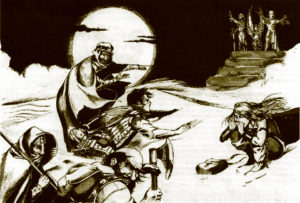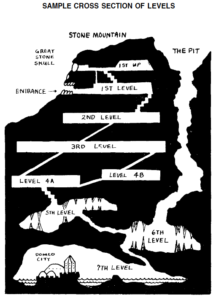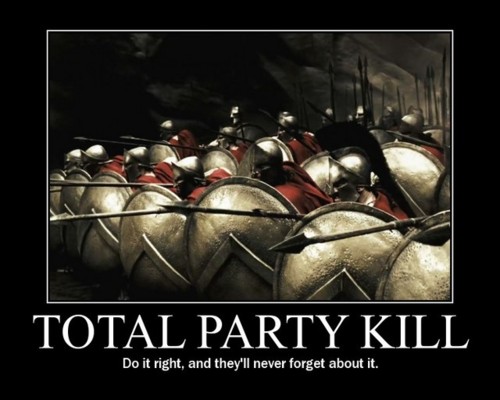When I was 12, I was living in a children’s home in Waco. One of the security guys at the place, Warren, was working there part time as he attended college. Warren took an interest in me and taught me how to play my guitar, made sure I got to play at Church on Sunday, and generally took the role of a ‘big brother’ in my life at a time when my birth mother had all but abandoned me.
One day, when at a flea market somewhere in that area, I had found a copy of the Expert set, still shrink-wrapped, for $2.50. I was fascinated by the game, having heard about it in the past from people who played it, and having seen numerous ads for it in Omni, Games, and other magazines at the time. I had even managed to  procure the little pocket electronic game, the one where you had to find a magic arrow and then use the process of elimination to find the dragon and shoot the arrow into its room to kill it. So I was primed, and the cover artwork dragged me in as surely as the grapple in that tiny electronic game.
procure the little pocket electronic game, the one where you had to find a magic arrow and then use the process of elimination to find the dragon and shoot the arrow into its room to kill it. So I was primed, and the cover artwork dragged me in as surely as the grapple in that tiny electronic game.
Of course, it was the Expert set, so I couldn’t make heads or tales of the basic play. Didn’t matter: I was fascinated, and even made a number of dungeons (which were more funhouse sites than anything that made coherent sense), despite not having the full rules to run them. Warren noticed the set one day, and told me that he was a D&D player, and would run a game for me and a few of the boys at the home…
Unfortunately, the administrators caught wind of the game and, having been advised by people from the American Psychiatric Association that D&D could lead to Very Bad Things™, cancelled the game (yes, for those of you who constantly seem to want to drag out and beat Pat Pulling’s corpse on a yearly basis, you can also blame the psychiatrists, who were against it before they were for it).
The point of all of that is to relate my experience, as a middle-schooler back in the early eighties, to that of modern middle schoolers, in particular, the ones I ran the game for, and compare the two.
WHERE TO START?
I admit, I’m a nostalgic old bastard, and I like to stick to the basics. So for a kid’s first game of D&D, I like to start them off with a basic module from the early days of the game. There are a lot of reasons:
- They are tried and true. After almost 4 decades, I know them, and can run a game with them at the drop of a hat.
- The best examples are not written with any particular ‘story’ in mind, but are, instead, little sandboxes that provide the DM and players with a lot of agency. Many of them, like B2, pack more potential in 32 pages than many modern ‘story’ adventures do in 128. As I told someone recently, it’s all about reading between the lines and being ready to react and roll with whatever the dice and the players’ actions stir up.
- I enjoy seeing someone else experience the environment that so enthralled me as a beginner, and then see them put their own spin on it. It’s like seeing it through new eyes, again and again. This is especially relevant when running the game for the modern middle schooler: can I recreate the wonder I experienced for kids who grew up as digital citizens?
Normally, I would go with B2: The Keep on the Borderlands for this, but not knowing how the modern middle schooler would handle the wide open agency of B2, I decided to go with a slightly more linear Mega-Dungeon, or at least, the closest thing B/X offered at the time, B4: The Lost City, to get them familiarized with the basic game tropes and way of doing things.
 B4 is, of course, another classic, and a great way to really force the players into the survival mindset that so typifies the 1st through 3rd level experience of B/X. There is no safe haven for them to return to, there is only the desert and the dungeon, and their survival depends on their thoroughly exploring the latter and making alliances with some of the other parties within. That last bit is very important: you can’t just run through the pyramid putting the smack down on everything you meet! You need the Cynidiceans to help you stay alive, and that means learning about their culture and helping them with their problems, which generates at least 6 levels worth of adventures all on its own (if the DM expands the dungeon as suggested).
B4 is, of course, another classic, and a great way to really force the players into the survival mindset that so typifies the 1st through 3rd level experience of B/X. There is no safe haven for them to return to, there is only the desert and the dungeon, and their survival depends on their thoroughly exploring the latter and making alliances with some of the other parties within. That last bit is very important: you can’t just run through the pyramid putting the smack down on everything you meet! You need the Cynidiceans to help you stay alive, and that means learning about their culture and helping them with their problems, which generates at least 6 levels worth of adventures all on its own (if the DM expands the dungeon as suggested).
THE ADVENTURE BEGINS…
The initial party was 8 kids strong, with a smattering of every class represented at least once. I carefully explained how gameplay worked, and how to question me about their environment before they made decisions. As with any group of teenagers, there are those who naturally take the lead and those who must be prompted, but after an initial warm-up period in the desert to get everyone making decisions on their own, they found the lost city, and began exploring the top of the pyramid.
The first thing that struck me, was how easily many of them slipped into the investigative mode of  dungeon exploration. They took the descriptions I gave them and really started to dissect their environment. Some were curious about the statues at the top of the structure. Others examined the perimeter of its base and discovered the secret door. They then asked about a dozen questions about the hobgoblin corpse (including the inevitable “Is there anything valuable on it”).
dungeon exploration. They took the descriptions I gave them and really started to dissect their environment. Some were curious about the statues at the top of the structure. Others examined the perimeter of its base and discovered the secret door. They then asked about a dozen questions about the hobgoblin corpse (including the inevitable “Is there anything valuable on it”).
You really saw how seriously some of them took this facet of play when you watched the lone thief scout out the way forward. He checked every corner, came up with creative ways to open the door into the inner chamber, and checked the handles of every one of the brass cylinders before finally choosing to turn the handle on one. You would think that, after he missed the pit trap in the floor and plummeted to his doom, he would have soured on playing thieves, but no. His next character, another caravan traveller who wandered in from the desert a bit later, was a thief. This kid truly grokked the spirit of the game.
The second thing that struck me about this batch of kids, is how little they understood the power of teamwork in the game. The gas trap, for example, set them scampering left and right, every man for themselves, in panic mode. Because of of this, at least two more characters died, one from trying to figure out and stop the gas by himself (he didn’t and the gas would plague a number of other unfortunates who came into the room later), the other from going unconscious and being unceremoniously dropped down a ladder without anyone to catch him below.
The battle against the fire beetles below fared little better, but at least half of them made it into the machinery room alive after several flasks of lantern oil were sacrificed to set the little beggars alight.
 Now, I have to say at this point that this is almost exactly the same problem we had back in the day. As middle schoolers, our overactive hormones, mixed with our sense of excitement over this new type of game, led to many similar catastrophes. My very first character, a Halfling Thief (Warren used a mix of B/X and AD&D) died at least twice, and only survived due to the generous ‘inheritance’ of 1 healing potion that each of our characters received at the beginning of the game. Why did I keep dying? Because, in my excitement I kept rushing in to bad situations. And there was also that whole ‘Bree Yark!’ thing (and if you’ve played B2, you’ll know what I’m talking about).
Now, I have to say at this point that this is almost exactly the same problem we had back in the day. As middle schoolers, our overactive hormones, mixed with our sense of excitement over this new type of game, led to many similar catastrophes. My very first character, a Halfling Thief (Warren used a mix of B/X and AD&D) died at least twice, and only survived due to the generous ‘inheritance’ of 1 healing potion that each of our characters received at the beginning of the game. Why did I keep dying? Because, in my excitement I kept rushing in to bad situations. And there was also that whole ‘Bree Yark!’ thing (and if you’ve played B2, you’ll know what I’m talking about).
Thus ended their first session, with 4 dead party members, and their first true taste of old school gaming. They took to it with enthusiasm and were chomping at the bit for the next session.
THE HALLWAY…
After some time exploring the forge area, the party was joined by another group of travelers from the caravan (basically, at this point, I allowed character replacements to come in from the desert in staggered groups) and the exploration continued. They chose the NW door and made their way up and around to the northern hallway, which contained a number of interesting doors for them to explore. They rested in a room full of old crates, and the thief, scouting ahead, discovered the room with green slime (I switch rooms 5 & 8, so they found that one first). He managed to avoid the slime through careful examination before entering the room, guessing that the green goo was not good to walk through, and seeing nothing else of value, closed the door.
It was then that they ran into their first wandering monster party: a band of goblins coming around the bend caught the thief by surprise as he closed the door to the green slime room. To my surprise, the first thing he did was try to negotiate with the critters, offering food in exchange for friendship. Unfortunately, the wee beasties decided (due to a really bad roll on the reaction table) that whatever he had to offer could be had more easily and cheaply off of his dead body. They, of course, didn’t know that he had several comrades around the corner, so when the thief chose the better part of valor and ran, they gave pursuit.
A rare showing of coordination between the members of the party soon put the goblins down, with archers shooting from the rear, and an elf with a 2-handed sword making great account of himself. The kids basked in their victory and looted the bodies, which I actually chose to use a higher treasure type for, as this was their first real wandering encounter and they handled it so well. this gave them some gold and, miraculously enough, a magic item: a crystal ball! Maybe I was a bit too generous, but they never even tried the crystal, and they wouldn’t get nearly so nice a haul off of future goblins, so no harm done. A good end to their second session.
… OF ENDLESS DOOM.
They never got out of that hall.
For some reason, they just couldn’t decide what to do in the next session and, after opening a door that revealed a room with pixies, they argued for a time on what to do. One player was heavily offended that the pixies didn’t like him and spent a great deal of time trying to figure out how to ‘get’ them. They flew into a tiny vent at the top of one of the corners of the room and he spent a good deal of effort stuffing ancient fireworks into the hole to try and smoke them out.
Another group decided to smash everything in the room, including the jars in the hall outside it. This of course, prompted several wandering monster checks and, sure enough, another troupe of goblins came around the corner to investigate. But this time, the cooperation was almost non-existent. The kids went into panic mode, again, all looking to claim the glory, or save their skins, as their personalities dictated, but few coordinated their attacks. The elf with the two-handed sword, emboldened by his previous success, threw himself right into the middle of the goblins and, despite his dexterity and armor, was brought low by a sneaky stab from behind.
That, followed by the felling of the party dwarf, brought them back to their senses, and after a loss of yet one more party member, they managed to finish the little blighters off. They were mighty disappointed at the meager change earned off the goblin corpses, and gained far more by stripping their dead comrades. Damaged and spent, they closed the door to the fireworks room and prepared to rest for the night.
Their lookout, an elf who busied himself with searching for secret doors while the others slept, managed to hear some scuttling noises and whispering outside the door. For whatever reason, he decided to draw his weapon, but didn’t wake the rest of the party up. And as he party had done nothing to keep the door shut, no spiking, no barring, not even moving some boxes in the way, the goblins burst in en masse and started to attack the group.
Like the goblins that attacked them, it was brutish, ugly and short.
LESSONS LEARNED?
The kids learned some valuable lessons about teamwork and general dungeoneering practices (always spike those doors shut!), and had a great time doing it. The view that “kids these days wouldn’t have the patience or imagination for the old school manner of play,” is clearly not borne out by my experience. It might explain why 4E, a more video-gamey experience, didn’t fare so well, and 5E is a (partial) call back to the previous of doing things, with a lot of old school ethos behind its design.
I had a lot of fun sharing my experience with them, and watching them puzzle it out on their own with un-jaded eyes. There are a few things that really stand out about dealing with kids this age, though:
- Short sessions are a must. One thing I can say about the modern kid is their attention spans for this sort of thing are much shorter. About an hour in they start to get ‘punchy’ and wound up beyond the ability to play rationally, and an hour and a half is about the limit.
- I never understood the wisdom of the ‘Caller’ position before, and I don’t personally know anyone who ever considered using it. After the last three sessions, however, it is clear that this is the only way to go with the modern middle schooler. Take the bickering and shouting back and forth of yesteryear, multiply it by about 5, and add a mental image of me rubbing my eyes with exhaustion (something Warren never did), and you get the picture. Putting the power of the Caller in the hands of the most ‘mature’ player, and giving them a time limit that ends in a wandering monster check, definitely helps to speed the game along.
- The design decisions to make D&D characters more survivable, by tripling their HP at first level, healing surges, or what-not to keep the modern gamer interested in the game? Needless. These kids all rolled their starting hit points. Some had 1 to start with. They littered that pyramid with their characters bodies… and they loved it. If anything, the video game generation is quite used to the concept of a character meatgrinder, and took the rolling of a new character as a fun mini-game. I also explained before the game the whole concept of the ‘Greek Gods & Heroes’ paradigm of looking at their characters, the nature of legend (for every Conan, there are 999 failed adventurers whose skeletons serve as the set dressing for the dungeons the PCs are exploring), and how gratifying it is to have that first character reach level 2, not by artificial inflation of stats, HP or XP, but by sheer player cunning (player skill over mechanical skill) and a little bit of luck.
WHAT’S NEXT?
 After the TPK, the kids wanted to continue on, but as the school year is about over, I decided to put D&D away (for now) and introduce them to some other old school games. And as Infinity War was around the corner, I chose out TSR’s Marvel Super Heroes RPG. They are loving it. At this early stage, during character introductions, they are spending more time fighting each other than the bad guys, but they’ve just stumbled onto a pawn shop robbery and are starting to focus their attention on the three thieves, Lawrence, Maurice and Curly, and wondering how those knuckleheads managed to get their hands on advanced weaponry.
After the TPK, the kids wanted to continue on, but as the school year is about over, I decided to put D&D away (for now) and introduce them to some other old school games. And as Infinity War was around the corner, I chose out TSR’s Marvel Super Heroes RPG. They are loving it. At this early stage, during character introductions, they are spending more time fighting each other than the bad guys, but they’ve just stumbled onto a pawn shop robbery and are starting to focus their attention on the three thieves, Lawrence, Maurice and Curly, and wondering how those knuckleheads managed to get their hands on advanced weaponry.
Next year, I’m planning on splitting up the Game Club into two clubs: the regular board-game club, and The Adventurers Guild: a roleplaying club with a standing Mega-Dungeon in the Gygaxian/Arnesonian paradigm, that anyone can explore on a weekly basis. That should be a lot of fun…




